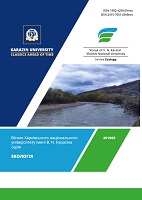Post-pyrogenic transformation of biogeochemical properties of grey forest soils under technological load
Abstract
Physical-chemical properties of soils in the post-fire period deteriorate due to a significant decrease in the amount of nutrients in the soil: humus burns, nitrate nitrogen content decreases. The acid-alkaline reaction according to the pH index in the soils affected by fires shifts to neutral, which should be explained by the saturation of the absorbing complex of soils with alkaline earth elements. Forest lowland fires significantly transform the morphological appearance of the upper part of the soil profile. Under the influence of fires, there are changes in pH, the content of exchangeable cations, gross and mobile forms of nitrogen, etc. The behavior and content of heavy metals in the forest floor is determined, in addition to the effect of fire and the geochemical state of the region, the speed of water migration and biological absorption, and the topography of the area. The concentration of heavy metals in the surface horizons of the soils of pine forests increases several times and exceeds the background concentrations as a result of the mineralization of the forest floor and grassy vegetation from combustion and subsequent migration of chemical elements.
Fires, on the one hand, improve the conditions for seed penetration into the soil, but worsen the conditions for the germination, growth and development of coniferous tree species. The concentration of heavy metals in the surface horizons of pine forest soils is an ecological hazard.
Downloads
Published
Issue
Section
License
Copyright (c) 2022 Буц Ю. В., Крайнюк О. В., Лоцман П. І., Сенчихін Ю. М.

This work is licensed under a Creative Commons Attribution 4.0 International License.
Authors reserve the right of attribution for the submitted manuscript, while transferring to the Journal the right to publish the article under the Creative Commons Attribution License. This license allows free distribution of the published work under the condition of proper attribution of the original authors and the initial publication source (i.e. the Journal)Authors have the right to enter into separate agreements for additional non-exclusive distribution of the work in the form it was published in the Journal (such as publishing the article on the institutional website or as a part of a monograph), provided the original publication in this Journal is properly referenced
The Journal allows and encourages online publication of the manuscripts (such as on personal web pages), even when such a manuscript is still under editorial consideration, since it allows for a productive scientific discussion and better citation dynamics (see The Effect of Open Access).

